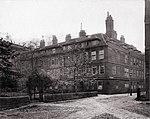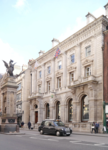Prince Henry's Room
Defunct museums in LondonGrade II* listed buildings in the City of LondonHistoric house museums in LondonHouses in the City of LondonIndividual rooms ... and 6 more
Literary museums in LondonMuseums in the City of LondonMuseums with year of establishment missingTimber framed buildings in EnglandUse British English from November 2014Vague or ambiguous time from October 2019

Prince Henry's Room is situated on the first floor at the front of No. 17 Fleet Street, London. The house is one of the few surviving buildings in the City of London dating from before the Great Fire of London in 1666. It is a Grade II* Listed Building.
Excerpt from the Wikipedia article Prince Henry's Room (License: CC BY-SA 3.0, Authors, Images).Prince Henry's Room
Fleet Street, City of London
Geographical coordinates (GPS) Address Nearby Places Show on map
Geographical coordinates (GPS)
| Latitude | Longitude |
|---|---|
| N 51.513888888889 ° | E -0.11083333333333 ° |
Address
Coutts
Fleet Street
EC4A 2AG City of London
England, United Kingdom
Open on Google Maps










